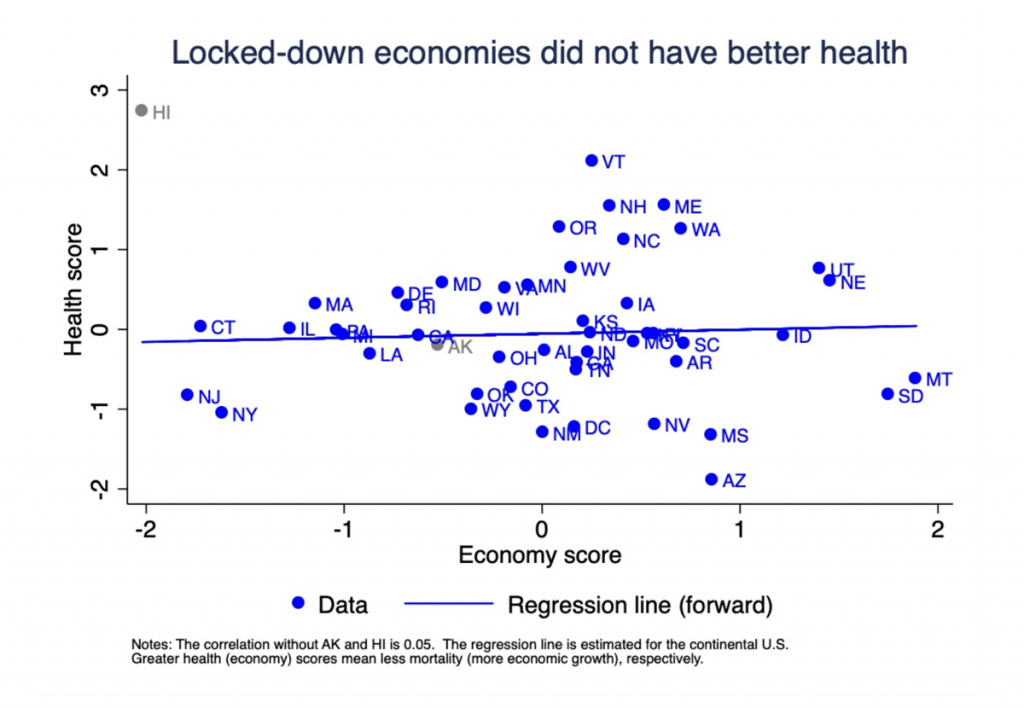Two years into the COVID-19 pandemic, even alarmist government officials like Dr. Anthony Fauci have admitted that it’s time to learn to live with the virus rather than disrupt our ordinary lives. In recent months, there has been a concentrated shift among our elected officials and expert class attempting to “move on” from the pandemic—perhaps because the policy decisions they made have aged so terribly.
Yet another comprehensive study was just released showing that the drastic lockdowns (“stay-at-home orders”) enacted in many US states did not meaningfully reduce COVID-19 mortality. Economists Casey P. Mulligan, Stephen Moore, and Phil Kerpen ran the numbers to rank all 50 states on COVID mortality, economic performance, and pandemic education outcomes (based on how much they were able to keep schools open).
The results show that despite their drastic, sometimes-lethal second-order consequences, government lockdowns did not meaningfully reduce COVID-19 mortality.
“Excluding the geographically unusual cases of Hawaii and Alaska to focus on the continental U.S., there is no apparent relationship between reduced economic activity during the pandemic and our composite mortality measure,” the authors conclude.
While one can find outliers in either direction, the data for the individual states analyzed in this paper support this general conclusion.
Florida, for example, was much-maligned for its hands-off approach to the pandemic.
“Florida Man Leads His State to the Morgue,” a New Republic headline blared.
“How did Florida get so badly hit by Covid-19?” asked the BBC.
“Ron DeSantis Plays Disaster Politics as Florida Again Reels From Coronavirus,” thundered US News.
Yet as the Wall Street Journal editorial board noted, Florida ranked 6th overall, 3rd for educational outcomes, 13th for economic outcomes, and 26th—pretty middle-of-the-pack—for COVID mortality. (Despite having a disproportionately elderly population!)
California, meanwhile, ranked 40th for its economic outcomes and 50th for education outcomes because it so heavily restricted its economy and kept its schools closed for so long. However, it ranked 27th for COVID mortality, marginally worse than Florida despite all the lockdown damage California inflicted on itself.
New York and New Jersey fared similarly dismally.
There were some states, like Hawaii, where drastic lockdowns did correspond with excellent COVID-19-related outcomes. However, they were exceptions to the norm, and can often be explained by other factors. (Like Hawaii being, you know, a series of islands).
This is hardly the first study to reach the conclusion that lockdowns didn’t work.
Consider, for example, a comprehensive literature review examining relevant studies published by Johns Hopkins University in February. It found that despite their drastic costs, “lockdowns have had little to no effect on COVID-19 mortality.”
Why? Well, other research also found that the most COVID spread occurred, paradoxically, at home. (Making “stay-at-home” orders tragically counterproductive).
But the real reason lockdowns failed is much more fundamental. Lockdowns failed because they were rooted in extreme hubris, a deadly arrogance from policymakers who believed that if they simply wielded enough concentrated power they could stop the spread of an uber-contagious virus. They decided to play God, and that decision proved disastrous.
The Greek philosopher Socrates once said that “True wisdom comes to each of us when we realize how little we understand about life, ourselves, and the world around us.”
Lockdown politicians should have heeded this ancient advice. Because, as yet another study just showed, their arrogance imposed drastic costs on citizens while failing to achieve better results.
Brad Polumbo
Brad Polumbo (@Brad_Polumbo) is a libertarian-conservative journalist and Policy Correspondent at the Foundation for Economic Education.
This article was originally published on FEE.org. Read the original article.



